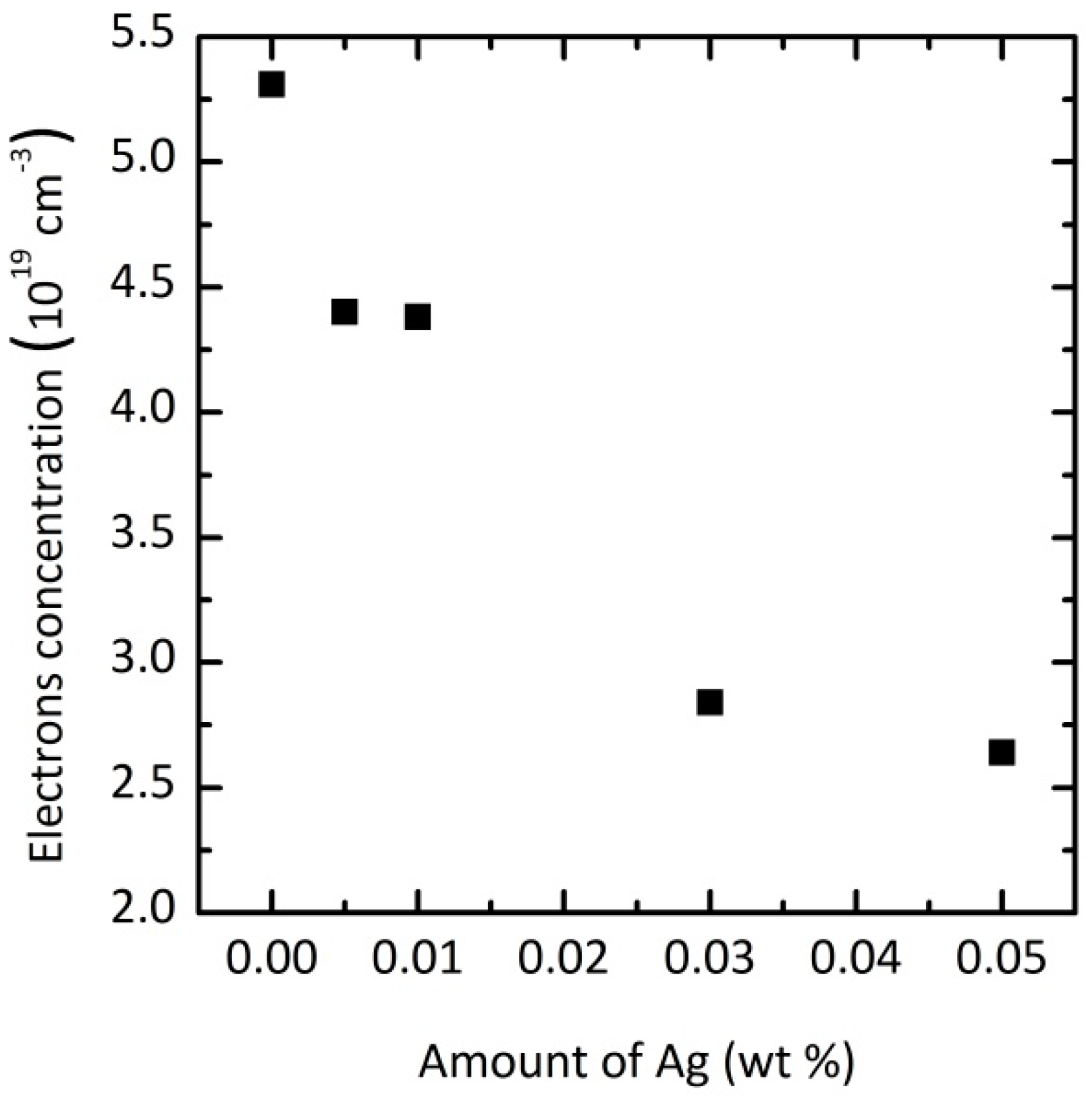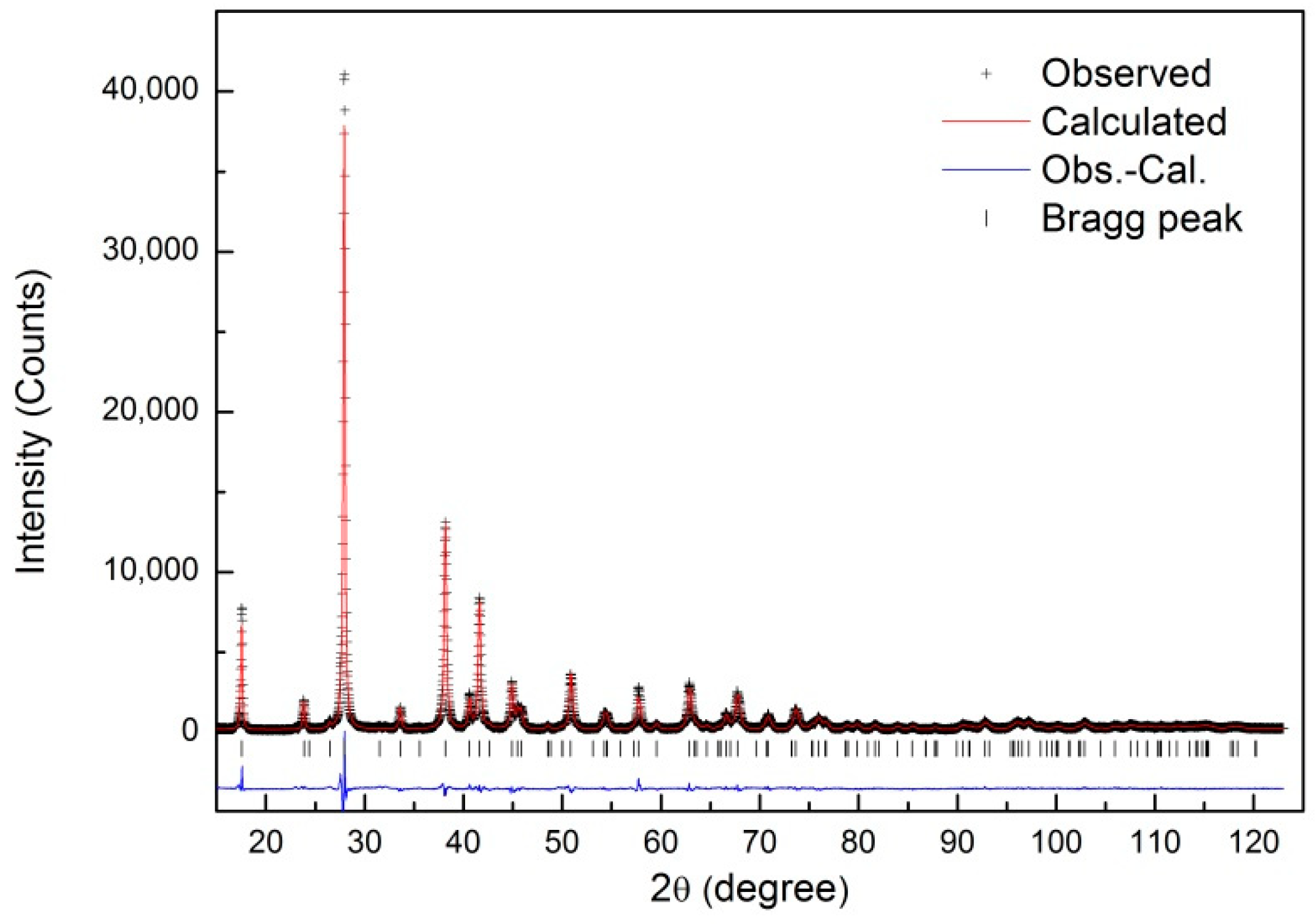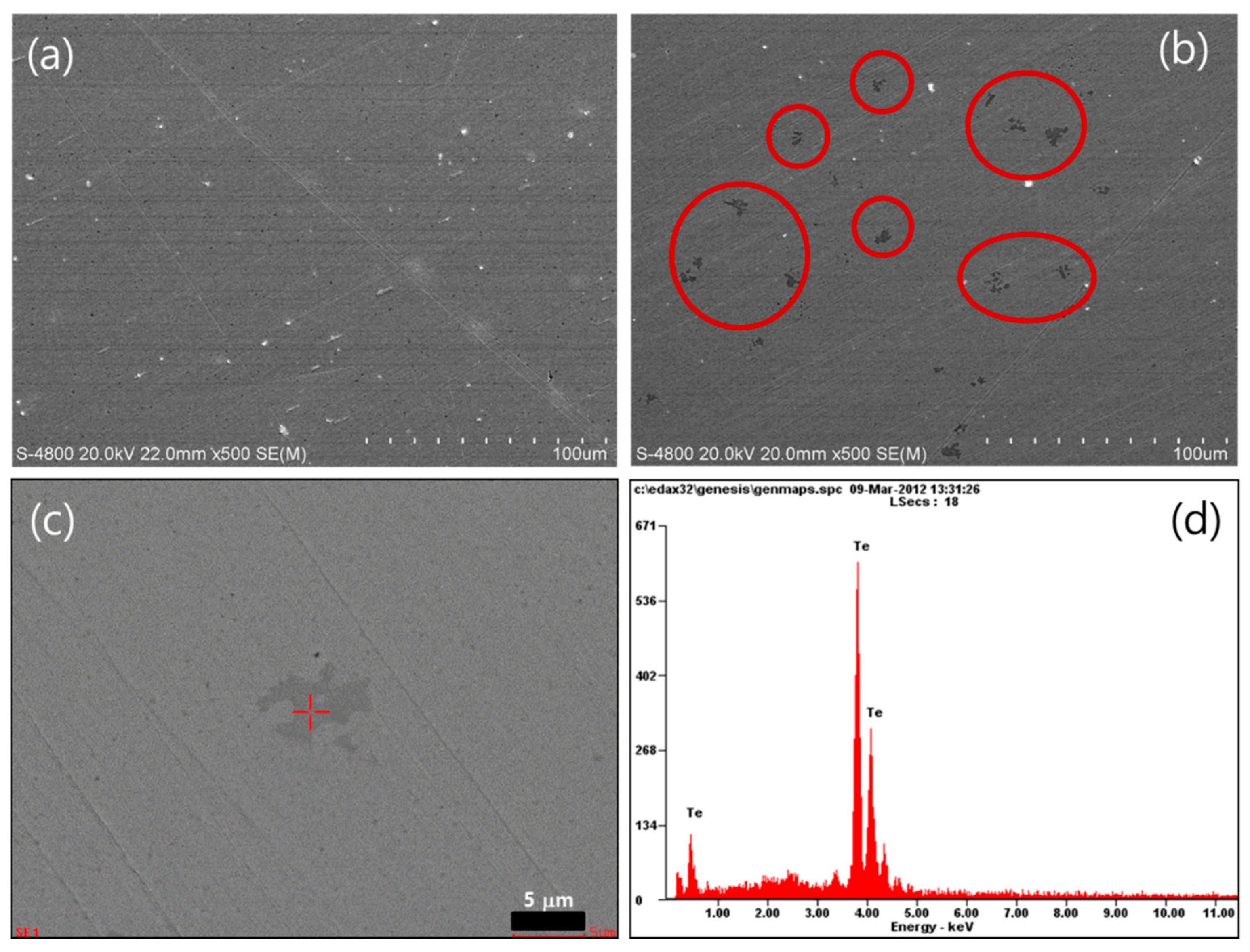Control of Carrier Concentration by Ag Doping in N-Type Bi2Te3 Based Compounds
Abstract
:1. Introduction
2. Materials and Methods
3. Results and Discussions
4. Conclusions
Author Contributions
Acknowledgments
Conflicts of Interest
References
- Snyder, G.J.; Toberer, E.S. Complex thermoelectric materials. Nat. Mater. 2008, 7, 105–114. [Google Scholar] [CrossRef] [PubMed]
- Sales, B.C. Smaller Is Cooler. Science 2002, 295, 1248–1249. [Google Scholar] [CrossRef] [PubMed]
- Poudel, B.; Hao, Q.; Ma, Y.; Lan, Y.; Minnich, A.; Yu, B.; Yan, X.; Wang, D.; Muto, A.; Vashaee, D.; et al. High-Thermoelectric Performance of Nanostructured Bismuth Antimony Telluride Bulk Alloys. Science 2008, 320, 634–638. [Google Scholar] [CrossRef] [PubMed]
- Seo, S.; Jeong, Y.; Oh, M.W.; Yoo, B. Effect of hydrogen annealing of ball-milled Bi0.5Sb1.5Te3 powders on thermoelectric properties. J. Alloys Compd. 2017, 706, 576–583. [Google Scholar] [CrossRef]
- Seo, S.; Oh, M.W.; Jeong, Y.; Yoo, B. A hybrid method for the synthesis of small Bi0.5Sb1.5Te3 alloy particles. J. Alloys Compd. 2017, 696, 1151–1158. [Google Scholar] [CrossRef]
- Kim, S.J.; Choi, H.; Kim, Y.; We, J.H.; Shin, J.S.; Lee, H.E.; Oh, M.W.; Lee, K.J.; Cho, B.J. Post ionized defect engineering of the screen-printed Bi2Te2.7Se0.3 thick film for high performance flexible thermoelectric generator. Nano Energy 2017, 31, 258–263. [Google Scholar] [CrossRef]
- Oh, M.W.; Son, J.H.; Kim, B.S.; Park, S.D.; Min, B.K.; Lee, H.W. Antisite defects in n-type Bi2(Te, Se)3: Experimental and theoretical studies. J. Appl. Phys. 2014, 115, 133706. [Google Scholar] [CrossRef]
- Seo, S.; Lee, K.; Jeong, Y.; Oh, M.W.; Yoo, B. Method of efficient Ag doping for Fermi level tuning of thermoelectric Bi0.5Sb1.5Te3 alloys using a chemical displacement reaction. J. Phys. Chem. C 2015, 119, 18038–18045. [Google Scholar] [CrossRef]
- Son, J.H.; Oh, M.W.; Kim, B.S.; Park, S.D.; Min, B.K.; Kim, M.H.; Lee, H.W. Effect of ball milling time on the thermoelectric properties of p-type (Bi,Sb)2Te3. J. Alloys Compd. 2013, 566, 168–174. [Google Scholar] [CrossRef]
- Ryu, B.; Oh, M.W. Computational Simulations of Thermoelectric Transport Properties. J. Korean Ceram. Soc. 2016, 53, 273–281. [Google Scholar] [CrossRef]
- Lee, K.H.; Kim, S.W. Design and Preparation of High-Performance Bulk Thermoelectric Materials with Defect Structures. J. Korean Ceram. Soc. 2017, 54, 75–85. [Google Scholar] [CrossRef]
- Kulbachinskii, V.A.; Kaminskii, A.Y.; Kindo, K.; Narumi, Y.; Suga, K.; Lostak, P.; Svanda, P. Ferromagnetism in new diluted magnetic semiconductor Bi2−xFexTe3. Physica B 2002 311, 292–297. [CrossRef]
- Plecháček, T.; Navrátil, J.; Horák, J.; Lošťák, P. Defect structure of Pb-doped Bi2Te3 single crystals. Philos. Mag. 2004, 84, 2217–2228. [Google Scholar] [CrossRef]
- Han, M.K.; Ahn, K.; Kim, H.J.; Rhyee, J.S.; Kim, S.J. Formation of Cu nanoparticles in layered Bi2Te3 and their effect on ZT enhancement. J. Mater. Chem. 2011, 21, 11365–11370. [Google Scholar] [CrossRef]
- Liu, W.S.; Zhang, Q.; Lan, Y.; Chen, S.; Yan, X.; Zhang, Q.; Wang, H.; Wang, D.; Chen, G.; Ren, Z. Thermoelectric property studies on Cu-doped n-type CuxBi2Te2.7Se0.3 nanocomposites. Adv. Energy Mater. 2011, 1, 577–587. [Google Scholar] [CrossRef]
- Park, Y.H.; Liu, X.D. Thermoelectric Properties of Bi-Sb-Te-X Compounds Prepared by MA-PDS Method. Mater. Res. Soc. Symp. Proc. 2002, 691. [Google Scholar] [CrossRef]
- Lee, J.K.; Park, S.D.; Kim, B.S.; Oh, M.W.; Cho, S.H.; Min, B.K.; Lee, H.W.; Kim, M.H. Control of thermoelectric properties through the addition of Ag in the Bi0.5Sb1.5Te3 alloy. Electron. Mater. Lett. 2010, 6, 201–207. [Google Scholar] [CrossRef]
- Klichová, I.; Loš;ťák, P.; Drašar, Č.; Navrátil, J.; BeneŠ, L.; Šrámková, J. Characterization of Ag-doped Sb1.5Bi0.5Te3 single crystals. Radiat. Eff. Defects Solids 1998, 145, 245–262. [Google Scholar] [CrossRef]
- Navrátil, J.; Klichová, I.; Karamazov, S.; Šrámková, J.; Horák, J. Behavior of Ag Admixtures in Sb2Te3and Bi2Te3 Single Crystals. J. Solid State Chem. 1998, 140, 29–37. [Google Scholar] [CrossRef]
- Yang, J.; Chen, R.; Fan, X.; Bao, S.; Zhu, W. Thermoelectric properties of silver-doped n-type Bi2Te3-based material prepared by mechanical alloying and subsequent hot pressing. J. Alloys Compd. 2006, 407, 330–333. [Google Scholar] [CrossRef]
- Lu, M.P.; Liao, C.N.; Huang, J.Y.; Hsu, H.C. Thermoelectric Properties of Ag-Doped Bi2(Se,Te)3 Compounds: Dual Electronic Nature of Ag-Related Lattice Defects. Inorg. Chem. 2015, 54, 7438–7444. [Google Scholar] [CrossRef] [PubMed]
- Nolas, G.S.; Sharp, J.; Goldsmid, J. Thermoelectrics: Basic Principles and New Materials Developments, 1st ed.; Springer: Heidelberg, Germany, 2001; pp. 111–131. ISBN 3-540-41245-X. [Google Scholar]
- Kresse, G.; Hafner, J. Ab initio molecular dynamics for liquid metals. Phys. Rev. B 1993, 47, R558. [Google Scholar] [CrossRef]
- Kresse, G.; Hafner, J. Ab initio molecular-dynamics simulation of the liquid-metal–amorphous-semiconductor transition in germanium. Phys. Rev. B 1994, 49, 14251. [Google Scholar] [CrossRef]
- Tkatchenko, A.; Scheffler, M. Accurate Molecular Van Der Waals Interactions from Ground-State Electron Density and Free-Atom Reference Data. Phys. Rev. Lett. 2009, 102, 073005. [Google Scholar] [CrossRef] [PubMed]
- Perdew, J.P.; Burke, K.; Ernzerhof, M. Generalized Gradient Approximation Made Simple. Phys. Rev. Lett. 1996, 77, 3865. [Google Scholar] [CrossRef] [PubMed]
- Scherrer, H.; Scherrer, S. CRC Handbook of Thermoelectrics, 1st ed.; Rowe, D.M., Ed.; CRC Press: Boca Raton, FL, USA, 1995; pp. 211–237. ISBN 0-8493-0146-7. [Google Scholar]
- Toby, B.H. EXPGUI, a graphical user interface for GSAS. J. Appl. Crystallogr. 2001, 34, 210–213. [Google Scholar] [CrossRef]
- Cordero, B.; Gómez, V.; Platero-Prats, A.E.; Revés, M.; Echeverria, J.; Cremades, E.; Barragán, F.; Alvarez, S. Covalent radii revisited. Dalton Trans. 2008, 21, 2832. [Google Scholar] [CrossRef] [PubMed]
- Hashibon, A.; Elsässer, C. First-principles density functional theory study of native point defects in Bi2Te3. Phys. Rev. B 2011, 84, 144117. [Google Scholar] [CrossRef]
- West, D.; Sun, Y.Y.; Wang, H.; Bang, J.; Zhang, S.B. Native defects in second-generation topological insulators: Effect of spin-orbit interaction on Bi2Se3. Phys. Rev. B 2012, 86, 121201(R). [Google Scholar] [CrossRef]
- Wang, L.L.; Huang, M.; Thimmaiah, S.; Alam, A.; Bud’ko, S.L.; Kaminski, A.; Lograsso, T.A.; Canfield, P.; Johnson, D.D. Native defects in tetradymite Bi2(TexSe3−x) topological insulators. Phys. Rev. B 2013, 87, 125303. [Google Scholar] [CrossRef]
- Horák, J.; Čermák, K.; Koudelka, L. Energy formation of antisite defects in doped Sb2Te3 and Bi2Te3 crystals. J. Phys. Chem. Solids 1986, 47, 805. [Google Scholar] [CrossRef]





| Atom | site | x/a | y/b | z/c | g | Beq/Å2 |
|---|---|---|---|---|---|---|
| Te(1) | 3a | 0 | 0 | 0 | 1.0 | 1.86(1) |
| Te(2) | 6c | 0 | 0 | 0.7885(1) | 1.0 | 1.36(7) |
| Bi(1) | 6c | 0 | 0 | 0.3984(1) | 1.0 | 1.37(5) |
| Sample | Rwp (%) | a (Å) | c (Å) |
|---|---|---|---|
| Ag = 0.0 | 8.44 | 4.3377(1) | 30.2611(1) |
| Ag = 0.01 | 8.61 | 4.3375(1) | 30.2641(1) |
| Ag = 0.03 | 7.82 | 4.3380(1) | 30.2768(1) |
| Ag = 0.05 | 7.97 | 4.3387(1) | 30.2774(1) |
| Sample | Lattice Parameters (Å) | Formation Energy (eV) | ||
|---|---|---|---|---|
| a | c | Te-Rich | Bi-Rich | |
| Bi2Te3 | 4.421 | 30.478 | - | - |
| Agi | 4.443 | 30.660 | 0.68 | 0.68 |
| AgBi | 4.408 | 30.211 | 1.07 | 1.47 |
| AgTe(6c) | 4.422 | 30.046 | 1.83 | 1.57 |
| AgTe(3a) | 4.415 | 30.323 | 1.89 | 1.63 |
© 2018 by the authors. Licensee MDPI, Basel, Switzerland. This article is an open access article distributed under the terms and conditions of the Creative Commons Attribution (CC BY) license (http://creativecommons.org/licenses/by/4.0/).
Share and Cite
Lee, J.K.; Son, J.H.; Kim, Y.-I.; Ryu, B.; Cho, B.J.; Kim, S.; Park, S.-D.; Oh, M.-W. Control of Carrier Concentration by Ag Doping in N-Type Bi2Te3 Based Compounds. Appl. Sci. 2018, 8, 735. https://doi.org/10.3390/app8050735
Lee JK, Son JH, Kim Y-I, Ryu B, Cho BJ, Kim S, Park S-D, Oh M-W. Control of Carrier Concentration by Ag Doping in N-Type Bi2Te3 Based Compounds. Applied Sciences. 2018; 8(5):735. https://doi.org/10.3390/app8050735
Chicago/Turabian StyleLee, Jae Ki, Ji Hui Son, Yong-Il Kim, Byungki Ryu, Byung Jin Cho, Sookyung Kim, Su-Dong Park, and Min-Wook Oh. 2018. "Control of Carrier Concentration by Ag Doping in N-Type Bi2Te3 Based Compounds" Applied Sciences 8, no. 5: 735. https://doi.org/10.3390/app8050735





